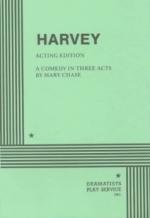|
This section contains 1,672 words (approx. 5 pages at 400 words per page) |

|
Herold has a Ph.D. and specializes in the history of dramatic literature. In the following essay, Herold discusses how Mary Chase's Harvey recycles familiar comic elements, drawing in particular on the ideas of Northrop Frye.
For a four year old boy to have an invisible friend is nothing extraordinary. However, when the "boy" is a forty-seven year old alcoholic bachelor with a horrified set of relatives, comedy ensues. This simple formula is complicated when other supposedly sane characters also admit to occasionally seeing the invisible friend, a six-foot white rabbit named Harvey. By the end of the play, the question is, who is better off, the sane but anxious Myrtle May or the deluded, pleasant, gentle Elwood? A big audience success, recipient of the prestigious Pulitzer Prize, and mostly glowing reviews, Harvey baffles the careful reader by somehow working, in spite of its flimsy premise, creaky...
|
This section contains 1,672 words (approx. 5 pages at 400 words per page) |

|




